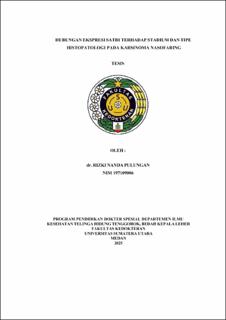Hubungan Ekspresi SATB1 terhadap Stadium dan Tipe Histopatologi pada Karsinoma Nasofaring
Relationship Of SATB1 Expression with Stage and Histopathological Type in Nasopharyngeal Carcinoma

Date
2025Author
Pulungan, Rizki Nanda
Advisor(s)
Lubis, Yuliani M
Farhat
Metadata
Show full item recordAbstract
Introduction: Nasopharyngeal carcinoma (NPC) is a squamous cell carcinoma originating from the epithelial lining of the nasopharynx, primarily affecting the lateral wall of the Rosenmüller fossa. NPC is a rare malignancy with distinct geographic and racial distributions, accounting for 0.7% of all cancers globally. The incidence of NPC in Indonesia is relatively high, with reported rates of 83 per 100,000 in males and 30 per 100,000 in females. Objective: This study aims to investigate the relationship between the expression of special AT-rich sequence- binding protein 1 (SATB1) and the level of invasiveness in nasopharyngeal carcinoma. Methods: This research is a descriptive study using a non- probability consecutive sampling technique. A total of 31 subjects diagnosed with stage III and IV nasopharyngeal carcinoma were included in the study. SATB1 expression levels were measured using Real-Time Polymerase Chain Reaction (RT- PCR) from biopsy samples. The study focuses on the correlation between SATB1 expression and histopathological type, tumor size, lymph node enlargement, and tumor stage. Results: The majority of NPC patients in the study were male (67.7%) with an average age of 45.94 years, the largest age group was 41-60 years (61.3%), non-keratinizing SCC histopathological type (90.3%) ; most tumor expansion was T4 (38.7%); KGB examination showed patients with N2 (61.3%); and the tumor stage was mostly stage IV (48.4%). Using the Mann Whitney test there was no significant relationship between SATB-1 expression and the histopathological type of nasopharyngeal carcinoma (p = 1.000) and using the Kruskal Wallis test there was a significant relationship between SATB-1 expression and the extent of nasopharyngeal carcinoma (p = 0.029); KGB concentration (p = 0.642); and nasopharyngeal carcinoma stage (p = 0.131) in nasopharyngeal carcinoma patients. Conclusion: There is a significant relationship between SATB1 expression and the expansion of nasopharyngeal carcinoma (p=0.029), but there is no significant relationship between SATB1 expression and the histopathological type of nasopharyngeal carcinoma (p=1.000), enlargement of lymph nodes in nasopharyngeal carcinoma patients (p=0.642), stage of nasopharyngeal carcinoma (p=0.131)
Collections
- Master Theses [204]
